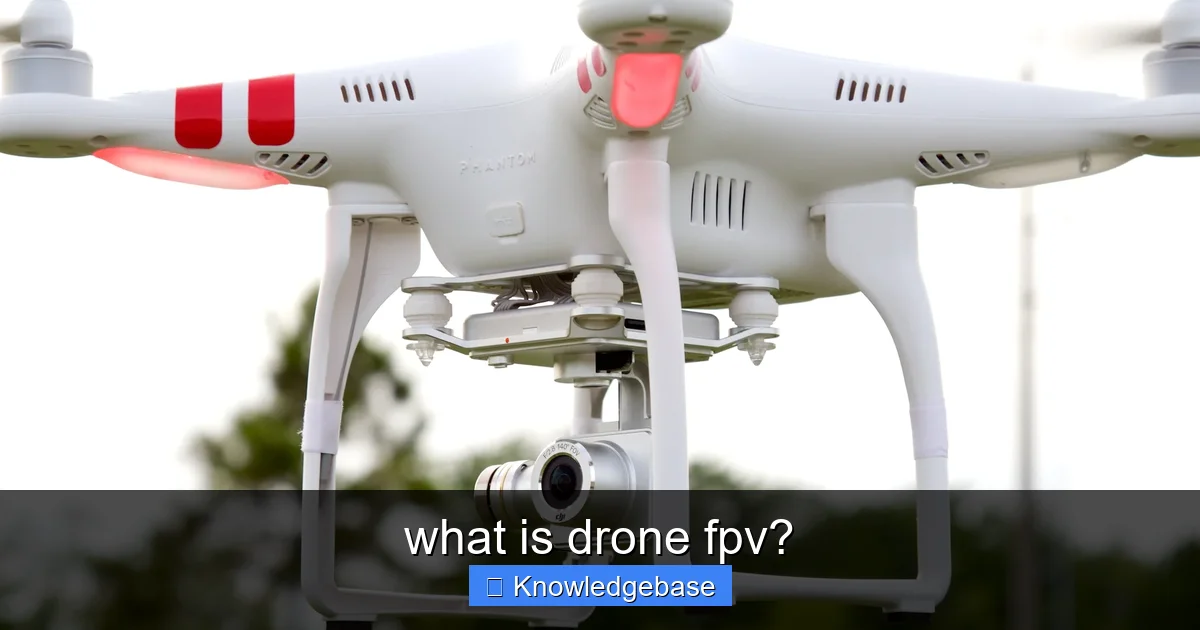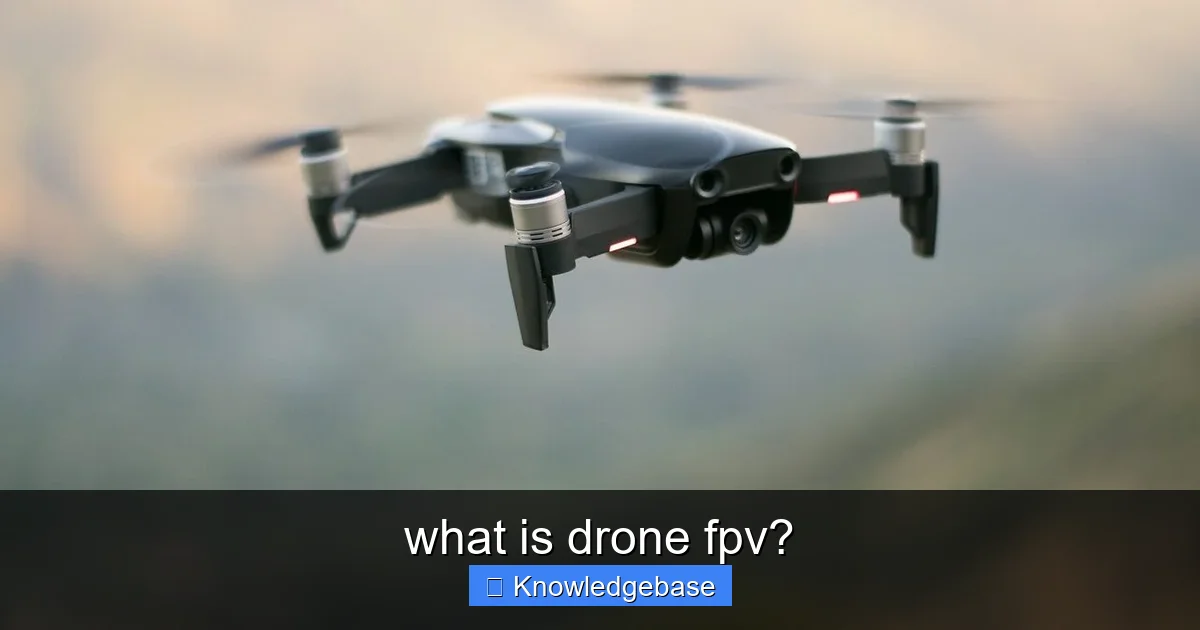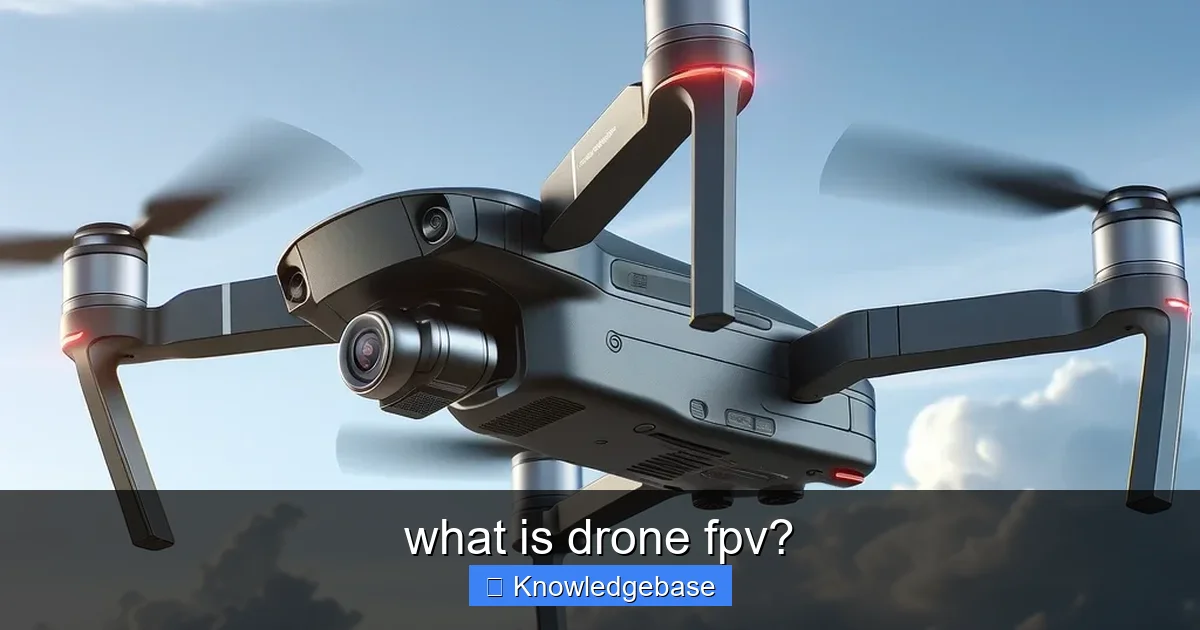
Featured image for this comprehensive guide about what is drone fpv?
Image source: cdn.arstechnica.net
What is Drone FPV?
Imagine soaring through the sky like a bird, weaving through trees, diving through canyons, or executing breathtaking acrobatic maneuvers, all while feeling like you’re actually *inside* the aircraft. This isn’t a scene from a sci-fi movie; it’s the exhilarating reality of **drone FPV** flying. For years, drones have captured our imagination, offering stunning aerial photography and videography from a safe distance. But **what is drone FPV**? It’s a whole different ballgame—an immersive, high-octane experience that puts you directly in the cockpit.
**First Person View (FPV)** transforms drone piloting from a detached, third-person operation into an incredibly personal and dynamic adventure. Instead of looking at your drone from the ground, you wear specialized goggles that display a real-time video feed directly from a camera mounted on the drone’s nose. This “eyes in the sky” perspective unlocks unparalleled precision, speed, and a visceral connection to your flight. Whether you dream of competitive racing, graceful freestyle acrobatics, or cinematic exploration, understanding **what is drone FPV** is the first step into a world where the sky is truly your playground.
This comprehensive guide will take you on a deep dive into the fascinating world of **drone FPV**. We’ll explore its core concepts, essential components, the critical debate between analog and digital systems, how to get started safely, and the diverse styles of FPV flying that have captivated a global community. Get ready to have your perception of drone flying completely redefined as we uncover everything you need to know about this thrilling technology.
Quick Answers to Common Questions
What does FPV actually stand for?
FPV stands for “First Person View,” meaning you experience flying the drone as if you were sitting right inside it. With drone FPV, you get a pilot’s-eye view, making the flight incredibly immersive!
How do you see what the drone sees with FPV?
A small camera on the drone streams live video wirelessly to special FPV goggles or a screen you wear or look at. This real-time feed is what gives you that thrilling drone FPV experience.
Why would someone want to fly a drone using FPV?
Flying drone FPV offers an incredibly immersive and precise piloting experience, allowing for thrilling acrobatic maneuvers, racing, or capturing cinematic shots from unique perspectives. It truly feels like you’re soaring through the air!
Is it difficult to learn how to fly drone FPV?
While drone FPV has a bit of a learning curve compared to camera drones, it’s very rewarding and accessible thanks to simulators and beginner-friendly kits. Many pilots start practicing in a simulator before taking to the real skies.
What essential gear do I need to get started with drone FPV?
To get into drone FPV, you’ll primarily need an FPV drone, a radio transmitter to control it, FPV goggles to see the live video, and batteries. There are many excellent “ready-to-fly” kits designed for beginners.
📋 Table of Contents
Decoding FPV: The Core Concept of First Person View
At its heart, **what is drone FPV**? It’s the technology that allows a drone pilot to see the world from the drone’s perspective in real-time. Unlike traditional line-of-sight (LOS) drone flying, where you manually track your drone in the sky, FPV immerses you directly into the flight experience, blurring the lines between pilot and aircraft.
How Does Drone FPV Work?
The mechanism behind **drone FPV** is elegantly simple yet incredibly powerful. It involves a chain of specialized components working in harmony:
- FPV Camera: Mounted at the front of the drone, this tiny camera captures the forward-facing view. It’s often designed for low latency, ensuring the video feed is as close to real-time as possible.
- Video Transmitter (VTX): Connected to the FPV camera, the VTX takes the camera’s video signal and transmits it wirelessly via radio frequencies. The power output of the VTX determines the range and signal penetration.
- Video Receiver (VRX) & FPV Goggles/Screen: On the pilot’s end, a VRX picks up the signal from the VTX. This receiver is typically integrated into a pair of FPV goggles or connected to a dedicated FPV monitor. The goggles then display the live video feed directly to the pilot’s eyes, creating an immersive experience akin to sitting inside the drone.
- Radio Transmitter (Controller): While the FPV system handles the video, a separate radio transmitter (your drone’s controller) is used to send control commands to the drone, dictating its movements. This controller typically uses a different frequency band (e.g., 2.4GHz or 900MHz) than the video link.
This seamless integration means that when you steer your drone to the left, the image in your goggles immediately reflects that turn, providing an intuitive and direct connection to your flight.
Why Choose FPV Over Standard Drone Flying?
The appeal of **drone FPV** extends far beyond mere novelty. It offers distinct advantages that cater to a different kind of piloting experience:
- Unmatched Immersion: The most significant draw is the feeling of being in the air. This immersion translates into a profound sense of presence and control that LOS flying simply cannot replicate.
- Precision and Agility: With a direct view, pilots can navigate tighter spaces, execute complex maneuvers, and react to obstacles with far greater precision. This is crucial for disciplines like FPV racing and freestyle.
- Speed and Thrill: FPV drones are often designed for speed and agility, not just stable hovering. The immediate feedback loop of FPV goggles allows pilots to push these drones to their limits, offering an adrenaline-pumping experience.
- Creative Freedom: FPV opens up new avenues for cinematic shots, enabling dynamic movements and perspectives that are impossible with traditional camera drones. Think intricate dives, close-quarter tracking, and fluid, uninhibited motion.
- Skill Development: FPV flying is undeniably more challenging initially, but mastering it builds incredible spatial awareness, hand-eye coordination, and quick reaction times. It’s a skill that requires dedication but rewards immensely.
While traditional camera drones excel at stable, cinematic shots, FPV drones are about the *experience* of flight and the raw, unbridled control it offers.
| FPV Aspect | Description | Key Detail / Comparison |
|---|---|---|
| What is FPV? | First-Person View: An immersive drone piloting method where the pilot sees live video from the drone’s onboard camera. | Offers a ‘cockpit’ view, unlike traditional Line-of-Sight (LOS) flying. |
| Core Components | The essential hardware required for an FPV setup to transmit and receive video signals. | FPV Camera, Video Transmitter (VTX), Video Receiver (VRX, often in goggles), FPV Goggles/Monitor. |
| Primary Use Cases | Common applications and popular styles of FPV drone flying. | Drone Racing (e.g., DCL, MultiGP), Freestyle (acrobatic flight), Cinewhoops (smooth cinematic shots). |
| Key Advantages | The main benefits that FPV offers to pilots and content creators. | Enhanced immersion, precise control for complex maneuvers, dynamic and unique filming perspectives. |
| Latency (Video Delay) | The time delay from the camera capturing an image to it appearing in the pilot’s goggles. | Analog FPV: ~20-40ms (low-res); Digital FPV: ~30-60ms (HD/better quality). Crucial for responsiveness. |
The Essential Components of an FPV System
Building or buying an FPV drone involves understanding a suite of specialized components, each playing a crucial role in delivering that immersive flight experience. To truly grasp **what is drone FPV**, it’s essential to know its building blocks.
The FPV Drone (Quadcopter) Itself
The drone, often a quadcopter, is the flying platform. FPV drones differ significantly from their photographic counterparts:
- Frame: FPV frames are typically lightweight, durable, and designed for agility. They come in various sizes (e.g., 2-inch for TinyWhoops, 5-inch for racing/freestyle, 7-inch for long-range) and materials like carbon fiber.
- Motors & ESCs: Brushless motors provide power, and Electronic Speed Controllers (ESCs) regulate the power flow to each motor, enabling precise speed and direction control. These are chosen for high RPMs and quick response.
- Flight Controller (FC): This is the brain of the drone, processing pilot commands, sensor data (gyroscope, accelerometer), and adjusting motor speeds to maintain stable flight or execute maneuvers. Modern FCs run open-source firmware like Betaflight, allowing extensive customization.
- Battery: High-discharge-rate LiPo (Lithium Polymer) batteries are used to deliver the burst of power FPV drones demand. Voltage (e.g., 4S, 6S) and capacity (mAh) are key considerations, impacting flight time and power.
The FPV Camera
This is your eye in the sky. FPV cameras are designed with specific priorities:
- Low Latency: The most crucial factor. Any delay between the camera capturing an image and it appearing in your goggles can lead to disorientation and crashes. FPV cameras are optimized for near-instantaneous transmission.
- Image Quality: While not cinematic, FPV cameras offer good dynamic range to handle bright skies and dark ground simultaneously. Most are wide-angle for a broader field of view.
- Form Factor: Small and lightweight to fit easily onto the drone frame without adding significant bulk.
- CMOS vs. CCD: Older CCD sensors were known for better handling of light transitions; however, modern CMOS sensors have largely caught up, offering excellent performance at a lower cost and weight.
The Video Transmitter (VTX)
The VTX converts the camera’s signal into radio waves and sends it to your goggles. Key aspects include:
- Power Output (mW): Measured in milliwatts, higher power generally means better range and penetration through obstacles. Common values are 25mW (legal limit in many regions), 200mW, 600mW, or even 1W+.
- Frequencies & Channels: Most analog VTXs operate on 5.8GHz, with multiple channels available to avoid interference when flying with others.
- Antenna: The VTX’s antenna is vital for signal quality. Circularly polarized (CP) antennas (e.g., Pagoda, Axii) are preferred for their ability to reduce multipath interference.
The FPV Goggles or Screen
This is where the magic of immersion happens.
- FPV Goggles: The preferred choice for most serious FPV pilots. They come in two main types:
- Box Goggles: More affordable, larger, and often offer a wider field of view. Great for beginners.
- Slimline Goggles: More compact, typically higher resolution, and often feature dual screens (one for each eye). More expensive but offer superior immersion and clarity.
- FPV Screen/Monitor: A less immersive but viable option, especially for beginners or for spectators. They’re typically smaller monitors with an integrated VRX.
- Field of View (FOV): The angular extent of the scene seen through the goggles. A wider FOV generally translates to a more immersive experience.
- Diversity Receiver: Many goggles feature diversity receivers, meaning they have two antennas and automatically select the strongest signal, improving reception.
The Radio Transmitter (Controller)
Your connection to the drone’s flight controller, telling it what to do.
- Channels: Most modern radio transmitters offer 8-16 channels, allowing fine control over multiple drone functions.
- Protocols: These define how the radio transmitter communicates with the receiver on the drone. Popular options include FrSky, Crossfire (TBS), Ghost (ImmersionRC), and the increasingly popular ExpressLRS (ELRS), known for its long range and low latency.
- Ergonomics: Comfort and stick feel are personal preferences, but crucial for long flying sessions.
Understanding these components is key to selecting or assembling a system that perfectly matches your FPV aspirations.
Analog vs. Digital FPV: A Head-to-Head Comparison
One of the most significant advancements and ongoing debates in the FPV world revolves around the video transmission technology: analog versus digital. When discussing **what is drone FPV**, it’s crucial to understand these two distinct approaches.
Analog FPV: The Classic Choice
Analog FPV has been the backbone of the hobby for decades. It uses an older, well-established technology for video transmission.
Pros:
- Ultra-Low Latency: This is analog’s biggest strength. The delay from camera to goggles is incredibly minimal, often under 20ms, which is critical for high-speed racing and reactive freestyle flying.
- Affordability: Analog FPV systems are generally much cheaper to buy and maintain, making them an excellent entry point for beginners.
- Graceful Signal Degradation: As you fly further or encounter interference, the analog image degrades gradually, showing static (“snow”) before losing signal completely. This gives pilots a warning to turn back.
- Robust in Interference: While it shows static, analog signals are quite resilient and less prone to complete dropouts in environments with moderate interference.
- Wide Adoption & Components: The market is saturated with compatible analog components, offering vast choices and easy replacements.
Cons:
- Lower Resolution: The most apparent drawback. Analog video is typically low resolution (around 640×480 or even lower), resulting in a grainy, less detailed image.
- Noise and Static: Image quality is often affected by “noise” or “snow”, especially at range or in challenging RF environments.
- Limited Recording Quality: The video recorded on the drone (if equipped with an HD camera) is much higher quality than what the pilot sees live.
Digital FPV: The Modern Evolution
Digital FPV systems, spearheaded by DJI with their revolutionary DJI FPV System, and more recently by HDZero and Walksnail Avatar, offer a significant leap in video quality.
Pros:
- High Resolution & Clarity: Digital FPV provides a much sharper, clearer, and more detailed image (often 720p or 1080p), dramatically improving the visual experience.
- Superior Color and Dynamic Range: Colors are more vibrant, and the image handles light and shadow transitions better, making for a richer visual environment.
- Built-in DVR: Many digital systems record high-quality footage directly onto the drone’s unit or within the goggles, often at the same resolution the pilot sees.
- Advanced Features: Digital systems often include integrated OSD (On-Screen Display) with more customizable data, and sometimes even features like audience viewing via Wi-Fi.
Cons:
- Higher Latency (Historically): Early digital systems had noticeably higher latency than analog. While modern systems like HDZero and Walksnail have achieved very low latency (comparable to good analog), DJI’s system, while impressive, still has slightly higher latency that some competitive racers can feel.
- Higher Cost: Digital FPV systems are significantly more expensive, requiring a larger initial investment.
- “Hard” Signal Cutoff: Unlike analog’s graceful degradation, digital signals tend to be all-or-nothing. As you lose signal, the image can suddenly freeze or disappear entirely, offering less warning than static.
- Interference Challenges: While clearer, digital signals can be more susceptible to environmental interference, sometimes leading to complete image loss rather than just noise.
Which is Right for You?
The choice between analog and digital largely depends on your priorities:
- For Competitive Racing or High-Intensity Freestyle: Many top pilots still prefer analog for its absolute lowest latency, where every millisecond counts. However, HDZero and Walksnail are making significant inroads with their low-latency digital offerings.
- For Cinematic Flying, Cruising, or General Fun: Digital FPV is often the preferred choice due to its breathtaking image quality, which greatly enhances the immersive experience and often provides excellent recorded footage.
- For Beginners: Analog is often recommended due to its lower cost and more forgiving signal degradation, which can be less disorienting when learning.
Ultimately, both systems offer incredible experiences, and the best way to understand the difference is to try them out if possible!
Getting Started with Drone FPV: Your First Steps
Embarking on your **drone FPV** journey can seem daunting, but with the right approach, it’s an incredibly rewarding experience. Here’s how to lay a solid foundation for successful and safe FPV flying.
Simulator Training: Essential for Beginners
This is arguably the single most important piece of advice for anyone wondering **what is drone FPV** and how to get into it. FPV drones are fast, fragile, and require significant skill. Crashing a real drone costs time and money.
- Why Simulators? They allow you to practice endlessly without consequences. You can crash a thousand times in a simulator, learn from your mistakes, and build muscle memory for the complex controls.
- Recommended Simulators:
- Velocidrone: Highly realistic physics, popular among racers.
- DRL Simulator (Drone Racing League): Excellent for racing, good physics, and an engaging experience.
- Liftoff: Great graphics, diverse environments, and good for both racing and freestyle.
- Uncrashed: Known for its exceptional physics and realistic crash simulations.
- Controller Compatibility: Most FPV simulators work with a standard FPV radio transmitter (your actual drone controller) connected to your computer via USB, providing the most authentic practice experience.
Spend dozens of hours in a simulator before attempting your first real flight. It will save you immense frustration and expense.
Choosing Your First FPV Drone Kit
Once you’ve built some confidence in the simulator, it’s time to consider hardware.
- Ready-To-Fly (RTF) Kits: These are comprehensive packages that include a drone, goggles, and a radio transmitter, pre-bound and ready to fly. They are excellent for absolute beginners as they eliminate the complexities of component matching and building.
- Examples: BetaFPV Cetus X, EMAX Tinyhawk III, DJI Avata (a more advanced and expensive RTF digital option).
- Bind-N-Fly (BNF) / Plug-N-Play (PNP):
- BNF: Comes assembled but requires you to bind your own radio transmitter and sometimes your own FPV goggles. Offers more flexibility.
- PNP: Comes without a receiver or battery, allowing you to choose your preferred radio protocol and battery type.
- Build-Your-Own (BYO): For the technically inclined, building your own drone from scratch offers maximum customization and a deep understanding of the system. However, it requires significant technical knowledge and soldering skills.
- Drone Size Considerations:
- TinyWhoops (1-2 inch): Small, safe, quiet, great for indoor flying and learning basic controls. Less intimidating for first flights.
- 3-inch Drones: A good intermediate step, more powerful than Whoops but still relatively nimble and less destructive than 5-inch drones.
- 5-inch Drones: The standard for racing and freestyle. Powerful, fast, but require more open space and skill to fly safely.
Understanding Regulations and Safety
Flying FPV often falls under specific regulations due to the pilot’s obscured line of sight.
- Local Laws: Research the drone laws in your country and local area (e.g., FAA in the USA, EASA in Europe). Regulations vary widely and are constantly evolving.
- Visual Line of Sight (VLOS): In many jurisdictions, FPV flying requires a “spotter”—a second person who maintains visual line of sight with the drone at all times and can alert the FPV pilot to potential hazards. This is a critical safety measure.
- No-Fly Zones: Be aware of airports, military bases, national parks, and other restricted airspace. Use apps like B4UFLY or local aviation authority resources.
- Privacy: Always be mindful of privacy. Do not fly over private property without permission or record individuals without their consent.
- Safety First: FPV drones have exposed propellers that spin at high speeds. Always remove propellers when working on the drone, and always arm the drone away from yourself and others. Fly in open areas away from people, animals, and property.
Community and Resources
The FPV community is incredibly welcoming and a fantastic resource.
- Online Forums & Groups: Websites like RotorRiot, IntoFPV, and various Facebook groups are filled with experienced pilots willing to help.
- YouTube Tutorials: Channels from Joshua Bardwell, Oscar Liang, and others provide invaluable guides on building, configuring, and flying FPV drones.
- Local Clubs: Search for FPV clubs in your area. Flying with experienced pilots is an excellent way to learn, get advice, and stay safe.
By following these steps, you’ll be well-prepared to safely and confidently enter the thrilling world of **drone FPV**.
The Diverse World of FPV Flying Styles
**What is drone FPV** beyond just flying? It’s a broad spectrum of aerial artistry and competition, each style demanding unique skills and offering distinct rewards. The versatility of FPV drones allows pilots to explore a variety of disciplines, from high-speed races to graceful aerial ballets.
FPV Racing
This is where the competitive spirit of FPV shines.
- The Goal: To navigate a predetermined course of gates, flags, and obstacles as quickly as possible.
- Drone Type: Typically highly agile 5-inch (or smaller, like 3-inch or TinyWhoop) quadcopters optimized for speed and tight turns.
- Skills Required: Extreme precision, lightning-fast reflexes, excellent course memorization, and consistent throttle control.
- Community: Highly organized, with local clubs, national leagues (like the Drone Racing League – DRL), and international competitions.
FPV racing is an electrifying sport, pushing the limits of both pilot skill and drone technology.
FPV Freestyle
Often considered the “art form” of FPV, freestyle is about creative expression.
- The Goal: To perform acrobatic maneuvers, tricks, and fluid lines, often interacting with the environment (e.g., diving through gaps, power looping buildings).
- Drone Type: Robust 5-inch quadcopters built to withstand crashes, with good power-to-weight ratios for complex tricks.
- Skills Required: Creativity, spatial awareness, advanced stick control, and the ability to link tricks into a seamless “flow.”
- Content Creation: Freestyle pilots often record their flights in HD, editing them into impressive compilations that showcase their skill and unique style.
Freestyle flying is less about speed and more about artistry, allowing pilots to dance with gravity.
Cinematic FPV
Marrying the immersion of FPV with the demands of high-quality video production.
- The Goal: To capture smooth, dynamic, and often dramatic footage for films, commercials, music videos, or personal projects.
- Drone Type: Can vary. “Cinewhoops” (small, duct-protected drones) are popular for close-quarters shots, while larger, custom-built FPV rigs can carry heavier cinematic cameras (like GoPros or even mirrorless cameras) for grander, sweeping shots. Often tuned for smoother, less aggressive flight characteristics.
- Skills Required: Exceptional throttle and camera control for smooth motion, understanding of camera angles and composition, and a keen eye for visual storytelling.
- Growing Industry: Cinematic FPV is increasingly used by professional videographers to achieve shots impossible with traditional camera drones or manned aircraft.
This style bridges the gap between raw FPV thrill and polished visual storytelling.
Long-Range FPV
Exploring distant landscapes and pushing the boundaries of wireless technology.
- The Goal: To fly significant distances (often several kilometers) to explore remote areas, mountains, or coastlines.
- Drone Type: Larger drones (often 7-inch or even 10-inch) designed for efficiency, stability, and carrying larger batteries. Equipped with powerful video transmitters and robust control link systems (like Crossfire or ELRS) for reliable signal over distance.
- Skills Required: Deep understanding of radio frequency management, battery management, navigation, weather conditions, and emergency procedures.
- Regulatory Challenges: Often operates at the edge of or beyond visual line of sight, requiring specific permissions or operating within legal frameworks.
Long-range FPV is about adventure and exploration, demanding a high level of technical expertise and planning.
Tiny Whoop / Indoor FPV
Small-scale fun that’s perfect for learning and casual flying.
- The Goal: To fly small, safe drones indoors, often through household obstacles, or in small outdoor spaces.
- Drone Type: Micro-drones with ducted propellers (TinyWhoops) that are incredibly lightweight, durable, and safe to fly around people and furniture.
- Skills Required: Basic FPV control, fine motor skills, and often adapting to tight spaces.
- Accessibility: Low cost, easy to get started, and provides a safe environment to practice FPV fundamentals.
TinyWhoops offer immense fun and a fantastic entry point into FPV without the need for vast open spaces.
Each of these styles offers a unique flavour of the **drone FPV** experience, proving that this hobby is as diverse as the pilots who embrace it.
Key Drone FPV System Specifications at a Glance
To help consolidate your understanding of **what is drone FPV** and its core technologies, here’s a comparative look at key specifications, particularly highlighting the analog vs. digital divide and common drone sizes.
| Feature | Analog FPV System | Digital FPV System (e.g., DJI, HDZero, Walksnail) |
|---|---|---|
| Resolution | Low (e.g., 640×480, VGA) | High (e.g., 720p, 1080p) |
| Latency | Ultra-low (~10-25ms) | Low to Moderate (~20-40ms, improving rapidly) |
| Cost | Lower initial investment | Higher initial investment |
| Signal Degradation | Graceful (gradual static/snow) | Abrupt (pixelation, freeze, blackout) |
| Image Quality | Grainy, less detail, limited dynamic range | Clear, sharp, vivid colors, excellent dynamic range |
| Best For | Competitive racing, budget-conscious beginners, robust signal in interference | Cinematic flying, immersive cruising, professional use, clear recording |
| Drone Size (Propeller Diameter) | Typical Use Case | Environment | Key Characteristics |
|---|---|---|---|
| 1-2 inch (TinyWhoop) | Learning, Indoor FPV, casual fun | Indoor, very small outdoor spaces | Small, very durable, ducted props, lightweight, safe |
| 2.5-3 inch (Toothpick/Micro) | Beginner racing, light freestyle, small outdoor spaces | Small parks, backyard, some indoor (carefully) | More powerful than Whoops, agile, good power-to-weight, still relatively safe |
| 4-5 inch (Standard) | Racing, Freestyle, Cinematic FPV | Open fields, parks, abandoned buildings | High speed, high power, very agile, standard for competitive flying |
| 6-7 inch (Long-Range) | Cruising, Exploration, Long-Range FPV | Large open areas, mountains, coastlines | Stable, efficient, long flight times, can carry larger batteries/payloads |
This data should give you a clearer picture of the technical landscape and help guide your choices as you delve deeper into the FPV world.
Conclusion
We’ve journeyed through the intricate and thrilling world of **drone FPV**, from understanding its core concept – seeing the world through your drone’s eyes – to dissecting its essential components, navigating the analog vs. digital debate, and outlining the crucial first steps for beginners. We’ve also explored the rich tapestry of FPV flying styles, revealing that this hobby is as diverse as the aerial adventures it offers.
**What is drone FPV**? It’s more than just a technology; it’s an experience. It’s the adrenaline rush of skimming mere inches above the ground at breakneck speeds, the creative satisfaction of weaving intricate patterns in the sky, and the profound sense of connection to a machine in flight. FPV transforms you from an observer into an integral part of the aerial action, offering a level of immersion and control that few other hobbies can match.
Whether you aspire to become a competitive racer, a daring freestyle pilot, a cinematic aerial artist, or simply want to explore your local landscape from a breathtaking new perspective, the world of **drone FPV** welcomes you. With accessible simulator training, a wealth of online resources, and a vibrant global community, now is the perfect time to don those goggles and take to the skies. Prepare for an unforgettable adventure that will challenge your skills, ignite your passion, and forever change the way you see the world. The sky is calling – are you ready to answer?
🎥 Related Video: FPV Drones VS Normal Drones ⎸ What's the difference? Are FPV Drones Better? (yes)
📺 RCwithAdam

Learn more about what is drone fpv? – what is drone fpv?
Image source: dronesandyou.com

Learn more about what is drone fpv? – what is drone fpv?
Image source: decentcybersecurity.eu
Thanks to PCBWay for sponsoring this video. Check out https://www.pcbway.com/ for custom printed circuit boards, electronics, …
Frequently Asked Questions
What does FPV stand for in drone flying?
FPV stands for First Person View. It refers to the immersive experience of flying a drone as if you are sitting inside the cockpit, seeing the world through a live video feed from a camera mounted on the drone. This perspective allows for precise control and a thrilling sense of flight.
How does a drone FPV system actually work?
A drone FPV system works by transmitting live video footage from a small camera on the drone to a receiver connected to goggles or a screen worn by the pilot. This wireless video feed, usually analog or digital, happens in real-time, giving the pilot an immediate view of the drone’s surroundings. It’s essentially a live video link directly from the drone.
What are the main advantages of flying a drone with FPV?
The primary advantages of drone FPV are unparalleled immersion and precision control. This perspective allows pilots to navigate complex environments, perform agile maneuvers, and fly at high speeds with greater accuracy than traditional line-of-sight flying. It offers a much more dynamic and engaging flying experience.
Do I need special equipment to experience drone FPV?
Yes, to experience drone FPV, you will need specific equipment beyond just the drone itself. This typically includes FPV goggles (or a monitor) to receive the video feed, a video transmitter (VTX) on the drone, and a compatible FPV camera. Batteries, a radio controller, and a receiver are also essential components.
Is drone FPV difficult for beginners to learn?
Drone FPV can have a steeper learning curve compared to flying a standard camera drone due to the common use of manual control modes and lack of GPS assistance. However, with dedicated practice, starting on simulators, and using beginner-friendly FPV drones, new pilots can certainly master it. The reward is a highly engaging and skillful flying experience.
What’s the difference between flying an FPV drone and a regular camera drone?
The main difference lies in purpose and control: FPV drones are typically built for speed, agility, and the immersive first-person flight experience, often flown in full manual “acro” mode. Regular camera drones, like many DJI models, prioritize stable aerial photography and videography, featuring GPS stabilization and easier flight modes, usually flown line-of-sight or with a screen showing the camera view but not for immersive piloting.



